Dee Estuary Birding
Monthly Newsletter...
June 2023 Newsletter
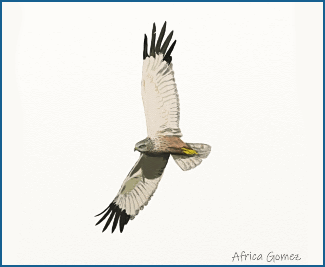
Up on the Roof
Something a
bit different this month, an article about rooftop nesting gulls by
Andy Harmer. See the Editor's note at the end of the article for
further details - Richard Smith.
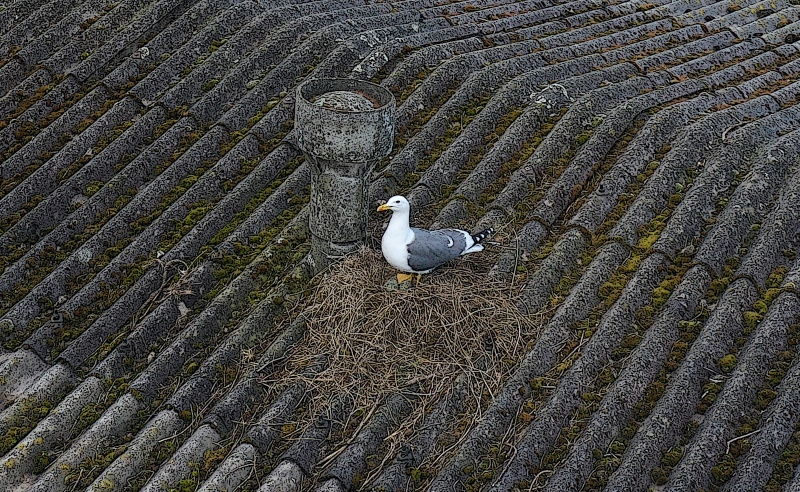
The concluding paragraph for the Lesser Black-backed
Gull text in the Birds in Cheshire and Wirral is as follows…
The author of Birds in Cheshire and Wirral, Professor David Norman,
predicted the spread of this species in 2008 and by 2022 Lesser
Black-backed Gull Larus fuscus
(LBG) has become a common breeder in
urban sites throughout Cheshire and Wirral. Herring Gull Larus
argentatus (HG), albeit in lesser numbers, has also achieved a
similar
distribution. Great Black-backed Gull Larus marinus (GBG) nests
have been found in amongst the larger gull colonies but appear
restricted in distribution to the industrial landscape in north
Cheshire and Wirral.
Unfortunately, there is a significant survey constraint in the
recording and monitoring of rooftop breeding gulls and that is the
inability to observe nesting habits because of the height of the
roofs. The crucial breeding data can be frustratingly just out of
reach of the recorder, but help is now here. Drones are now cheap
enough for even surveyors with the most meager of budgets, and the
size, weight, and safety features are enough to satisfy the Civil
Aviation Authority that some drones (sub 250 grams) can be used even in
heavily congested urban situations.
In the spring and summer of 2022, the author of this report used drones
to locate 1025 LBG nests, 222 HG nests, and 3 GBG nests on commercial
and residential structures across the recording area of Cheshire and
Wirral. 85 factory and warehouse roofs have supported over 99% of
all rooftop gull nests whereas less than 1% of gull nests were found on
the roofs of residential dwellings.
LBG outnumbered HG at every breeding colony except for one site at
Runcorn, where there were marginally more HG nests. Many breeding
colonies had little or no HG interest, whereas others had an almost
equal amount of LBG and HG nests. Size of colony, proximity to
the coast or ‘urban-ness’ appears to have no influence on the absence
of, or the percentages of, HG.
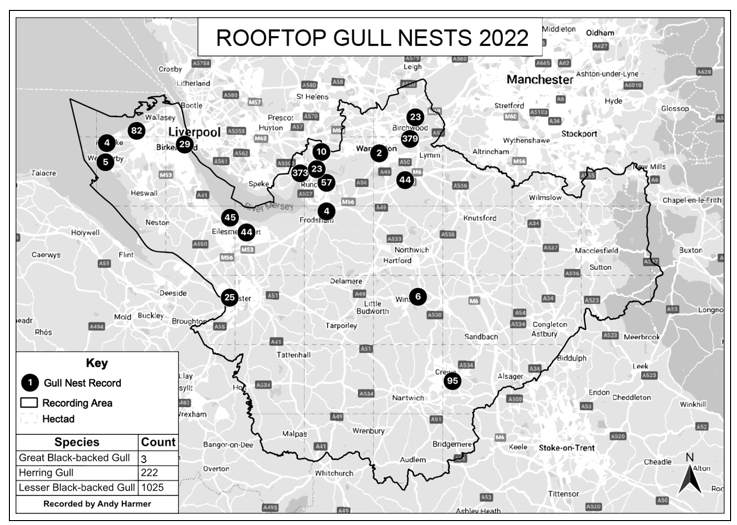
The author’s first drone sortie surveying for rooftop nesting gulls was
at an industrial estate in Runcorn, on the south bank of the river
Mersey. Prior to the survey, gull activity was observed
momentarily from the new Mersey Gateway Bridge, and as the bridge is
non-pedestrianised a proper inspection wasn’t possible. When the
factory was visited later that day, there was no evidence – as is
usually the case - to prove breeding, but any birder would wonder why
tens of adult gulls in the breeding season were swirling around a site
which presumably offered no food. A drone was required.
A cautious approach was required to safeguard any nesting birds, and
the drone. A take-off from the ground and a slow low flight away
from the structure was made whilst observing the reactions of the
gulls, tentatively ascending the drone to many metres above the roof
height, before moving lower to gauge reaction and get a better
view. The reaction of the gulls could be observed from a position
on the ground, as well as from the drone’s on-board camera. The gulls
were surprisingly nonchalant and allowed the drone to get closer and
closer until it was sometimes less than five metres away from the roof
lip. Breeding evidence of three species of gull could be seen,
and the survey’s first 25 HG nests, 24 LBG nests, and single GBG nest
was recorded at this site on this day.
| Location |
Factories/warehouses |
Residential |
| Appleton Thorn |
1 |
|
| Birkenhead |
7 |
|
| Chester |
3 |
3 |
| Clifton |
1 |
|
| Crewe |
4 |
|
| Eastham |
4 |
|
| Ellesmere Port |
7 |
|
| Hoylake |
4 |
|
| Moreton |
14 |
|
| Risley |
1 |
|
| Runcorn |
5 |
|
| Warrington |
1 |
|
| West Kirby |
1 |
4 |
| Widnes |
14 |
|
| Winsford |
4 |
|
| Woolston |
18 |
Table showing the type and number of roofs colonised at each location
Roof Preferences
The narrow scope of this survey means that the results are unlikely to
help our understanding of how and why a particular urban area attracts
and sustains gulls during recruitment. However, notes on roof
types (materials and structure) were made during the visits and these
are included within this article along with speculation as to why gulls
have a propensity to colonise these types of roofs.
The roof height appears less important than its ability to provide an
adequate barrier against mammalian predators (including humans).
Favoured roofs have gently sloped asbestos corrugation, single or
multiple ridged, with or without roof furniture such as air vents,
pipes, and skylights. The steeper the gradient, the greater the
propensity to utilise roof furniture as an anchor point. The roofs
usually have sides and edges, which on the face of it provides cover
from the worst of the elements, but it should be borne in mind that a
precipitous edge is a danger to the chicks so could this be a
safeguarding choice?
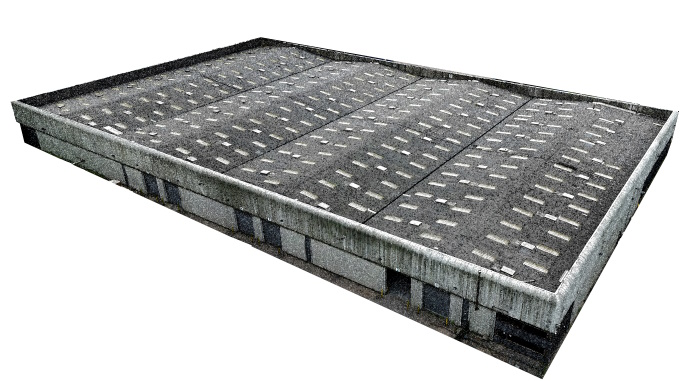
Asbestos corrugation, compared to metal roofing, offers much better purchase for nests, possibly even when the asbestos is at a steeper pitch. Asbestos corrugation roofs rapidly undergo bio-weathering, (bio-covering) and this is expedited by gulls. Gulls ostensibly ‘green the roofs’ that they nest on as their faeces provide nutrients for lichens and mosses, and nest construction brings in plants. Prey-item remains, faeces, and plant material can end up in the gutters and valleys of roofs which can impede drainage and then provide drinking water. There is evidence to suggest that nests on metal roofs ‘migrate’ downwards towards the gutters, valleys, or roof edge, and all of these could be disastrous for eggs and young.

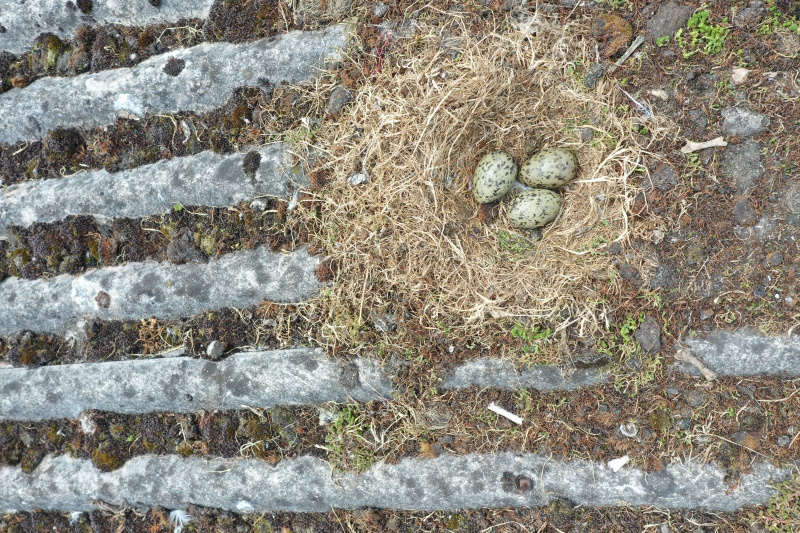
One benefit from choosing an asbestos roof became
obvious after the
chicks had hatched out. As a drone hovered above a roof in Widnes
sending a livestream back, it revealed that both nests on the roof were
empty, and predation appeared to be the reason as chicks were nowhere
to be seen. It was only when the drone camera viewed the roof
from the side that the chicks became visible. The mottled greys
and orange hues of the chicks could not have found a better backdrop
than a grey roof covered in Xanthoria and Physcia lichen rosettes.
Andy Harmer, andyharmer@btinternet.com.
References
1. David Norman, Birds in Cheshire and Wirral (a
breeding and wintering atlas), Liverpool University Press, 2008
This article originally published in Bird News
March 2023 (CAWOS - https://www.cawos.org/).
Editor's Note:
I wrote the gull section in the Cheshire and Wirral Bird Reports from
2004 to 2015 - and it was during that period that the large gulls went
from being rare breeding birds to becoming widespread across the
county, so it's no wonder that Andy's
article caught my eye. Just to give you an idea how rare breeding
Herring Gulls were, in 2000 the Bird Report mentions that a pair bred
at Hoylake raising one young, the first breeding pair in Cheshire and
Wirral since a pair at Heswall in 1976. In 2004 one pair bred in West
Kirby but there were indications that even by that year they were
starting to colonise as the Report goes on to say "Birds may also have
bred
at Hoylake, Wallasey and Birkenhead Docks". The first report of Lesser
Black-backed Gulls breeding on roof tops came in 2003 with a pair on a
roof near Bidston Dock, Birkenhead. In those days there were virtually
no breeding records outside Wirral of either species but by 2015, when
my stint of writing the gull accounts came to an end, I wrote that
there were 70 pairs of Lesser Black-backed Gulls and at least 15 pairs
of Herring Gull breeding on roof tops in Crewe, with many more
across the county.
It's
a similar story on the Welsh side of the estuary with both Herring
Gulls and Lesser Black-backed Gulls currently nesting on rooftops at
Connah's Quay, the Flint area and Mostyn Docks, where they had been
completely absent 20 years previously. The only numbers I have is 71
pairs of
Lesser black-backed Gulls nesting in Connah's Quay in 2019 counted
during an aerial survey. Many more large gulls breed in the Prestatyn
and Rhyl area and further west along the North Wales coast.
Data from Cheshire and Wirral Bird
Reports, 'The Breeding Birds of North Wales' 2013 and 'The Birds of
Wales' 2021.
"Harry" The Red-tailed Hawk
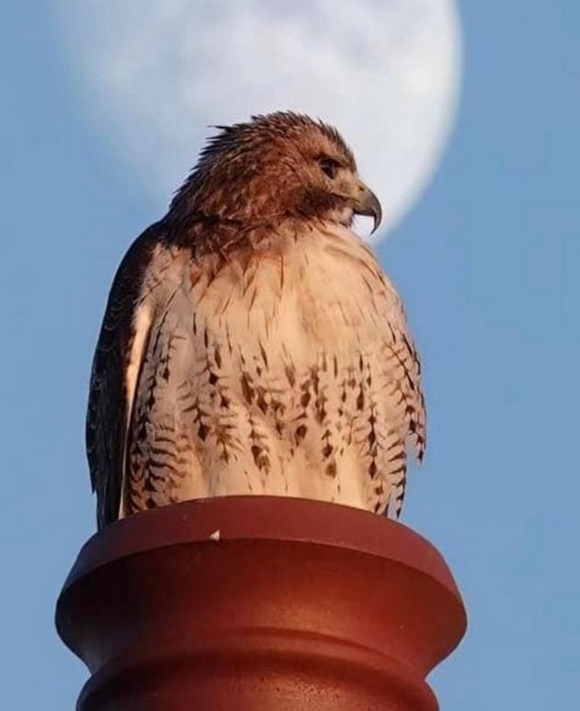
Most residents and regular visitors to West
Kirby will know all about a Red-tailed Hawk (nick-named 'Harry') which
was a falconer's escape in 2013 and since then frequently seen perched
on the roofs of Morrison's, the Dee Hotel (Wetherspoons) and other
buildings in the town centre. Unfortunately, it was found dead in
February 2023 but, for an escape, it did very well to survive 'in the
wild' for 10 years.
'Harry' was probably the most misidentified bird
ever in Wirral, frequently being recorded as an Osprey, Red Kite or
Common Buzzard. At one time it got to a stage when all Red Kite
sightings over West Kirby had to be dismissed unless they came from a
very reliable source, and I remember a couple of years ago somebody got
quite upset when I didn't believe his claim that there was an Osprey
perched on top of Lloyds Bank!
There is a reason I've written this short piece
about 'Harry' in this newsletter as there is a strong connection with
the above article on gulls as will become clear when I quote from what
I wrote in the Herring Gull account in the 2013 Cheshire and Wirral
Bird Report - "At least 10 prs bred in West Kirby although it appears
that many chicks were predated by an escaped Red-tailed Hawk". Andy
Harmer only recorded five pairs of Herring Gulls in West Kirby in 2022
so this reduction may well be because of the presence of this
Red-tailed Hawk, and it will be very interesting to see if numbers
increase now that 'Harry' is no more. But Herring Gull chicks were only
available as a food item for a few weeks each year so he must have
found other prey to feed on at other times. In their native America
Red-tailed Hawks eat rodents, including Squirrels, and we have an all
too plentiful supply of Grey Squirrels in the West Kirby area so I
suspect they were on the menu. I would also think both adult and young
Feral Pigeons would have been relatively easy for a Red-tailed Hawk to
catch.
No doubt whatever he preyed on will be glad to see the back of him, but we humans in West Kirby will miss our resident Red-tailed Hawk.
Richard Smith
Colour Ring Report
Redshank

m/G - G/YG
Ringed in Chichester Harbour in November 2017.
This bird has been seen every winter in Chichester Harbour
(Hampshire/West Sussex) since being ringed. The earliest it has been
recorded there is late August (2019) and the latest it has been seen is
early March (also in 2019).
The first record away from Chichester Harbour was at RSPB Leighton Moss
on 14/04/2018.
Since then it has been a regular spring visitor to RSPB Burton Mere
Wetlands where it has been recorded on the following dates: 25/03/2019,
26/05/2021, 15/05/2022, 17/05/2022, 01/04/2023 and 16/05/2023.
Presumably it's presence in spring at BMW, particularly in May, means
it breeds there.
Dunlin
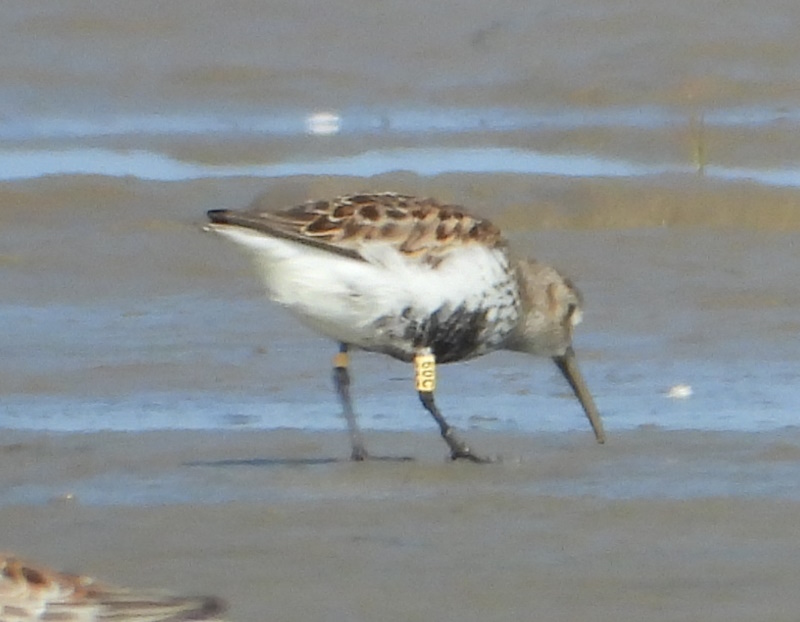
Y-Y(60C)
Ringed at Ynyslas on Cardigan Bay as a juvenile on 10/09/2018.
Recorded at Meols Shore on 20/05/2023.
Colour Rings were recorded by Richard Smith, Alex
Jones and Elliot Montieth.
Richard Smith
May Bird News
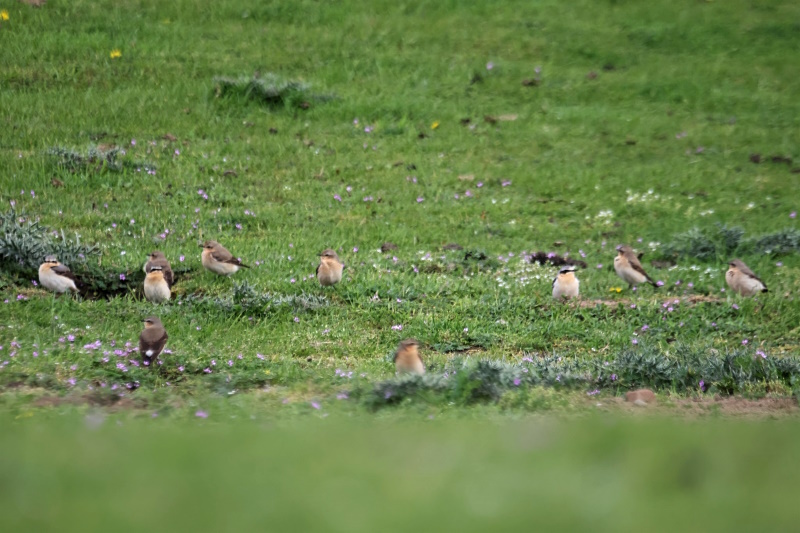
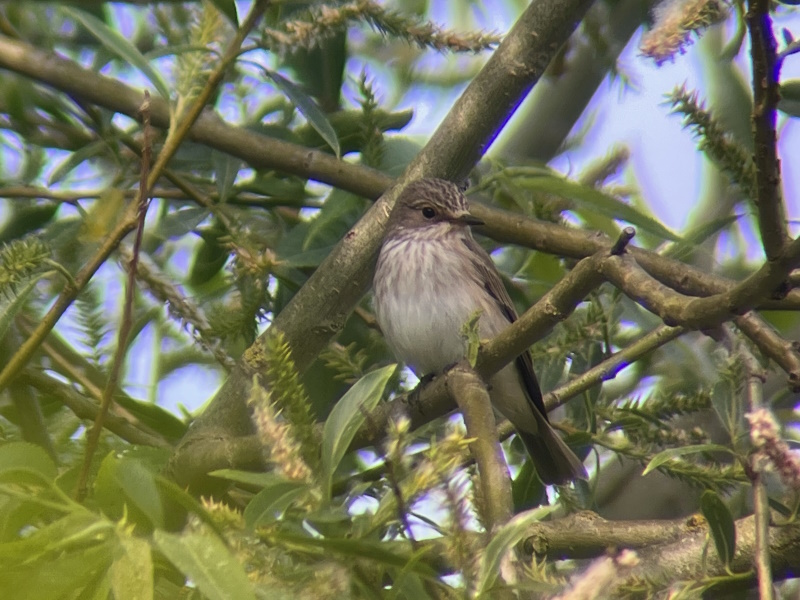
The spring migration was still well underway in
early May including at least 33 Wheatears and four Whinchats in the
Burton Marsh area on the 1st. The first spotted Flycatcher was seen on
the 5th but then it was just over two weeks later when we had the
second one. The peak occurred on the 29th with five ranging from Burton
to Hilbre. This was different to 2022 when all records were between the
13th and 22nd of May with a peak of eight on the 15th.
On the estuary Whimbrels were passing through in
good numbers with 184 at Heswall on the 2nd the highest count.
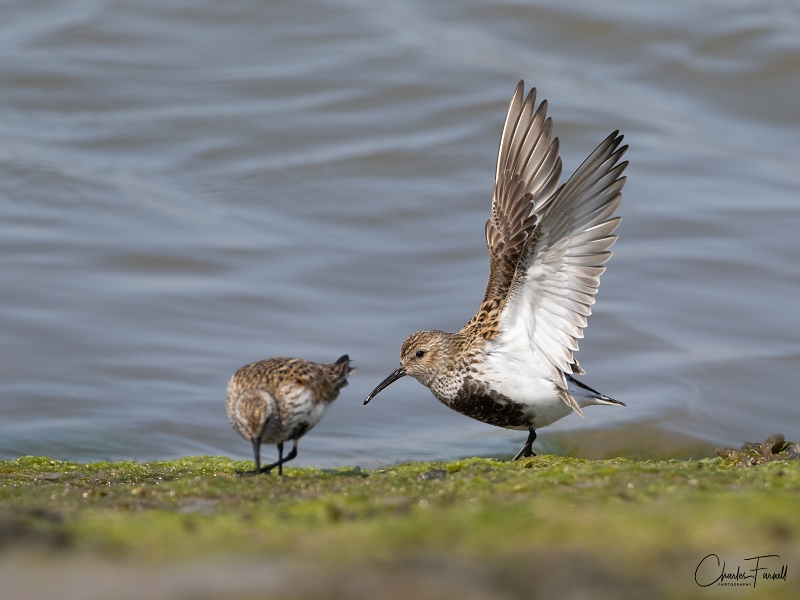
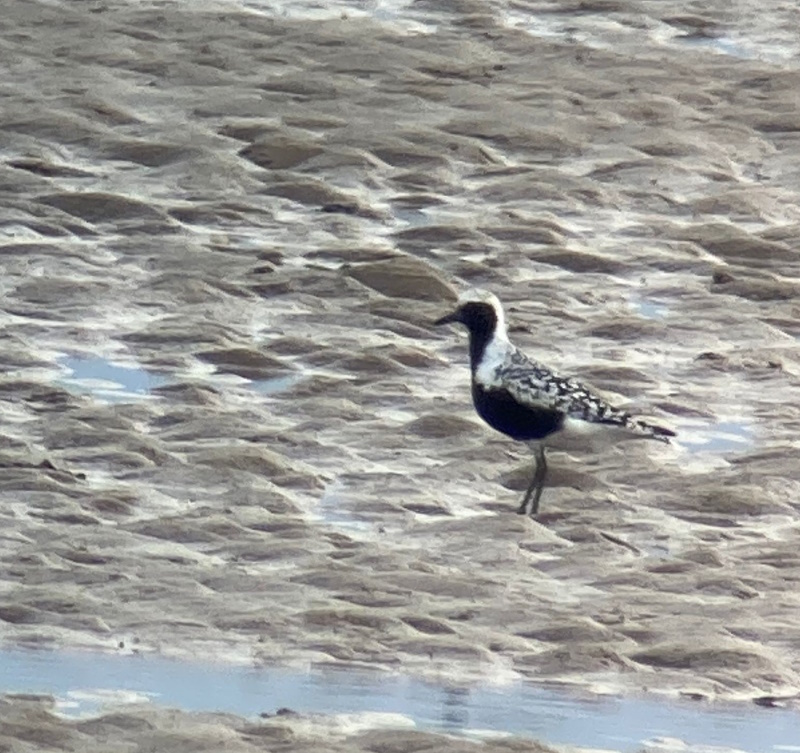
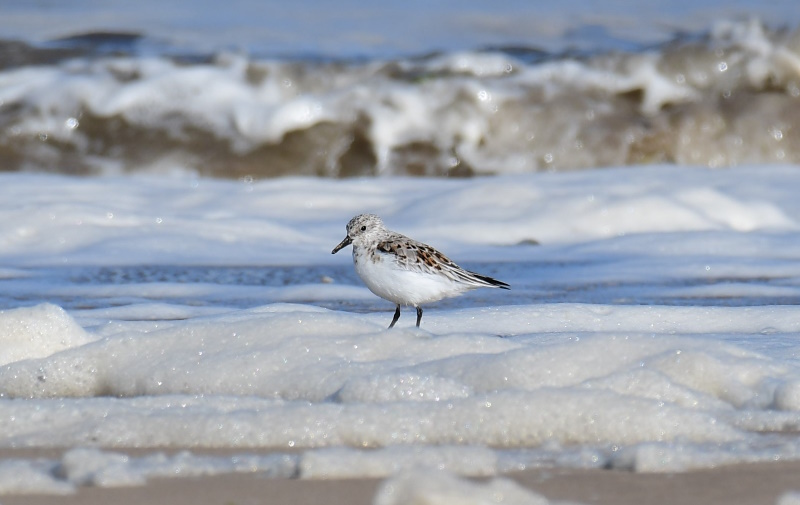
One of the joys of birdwatching in May is seeing waders in breeding
plumage as shown in the photos above, and many of these waders will
have flown up frpm Africa where they will have spent the winter. These
include a lot of Dunlin of the schinzii
and artica races, all
wintering in West Africa with the former mostly breeding in Iceland and
the latter in Greenland. All our over-wintering Dunlin (alpina race) will have left us by
April
and breed in northern Scandinavia and north-west Siberia. At least that
is what is supposed to happen, but every year, around mid to late May,
we get some big Dunlin at Hoylake which look distinctly Siberian. One
of
these is shown in the blue circle below with a massive beak, a richly
coloured back and a large black belly plate, this was photographed on
May 19th this year. Dunlins looking like this breed in the far-east of
Siberia and if you saw this bird on the shores of the Bering Strait it
wouldn't look out of place. Dunlins belonging to races which breed in
the eastern half of Siberia shouldn't be anywhere near the UK in May!
So the presence of these 'Siberian' Dunlin
at Hoylake is an intriguing mystery and I go into more details in
my Dunlin
- Rings, Races and Genes article.
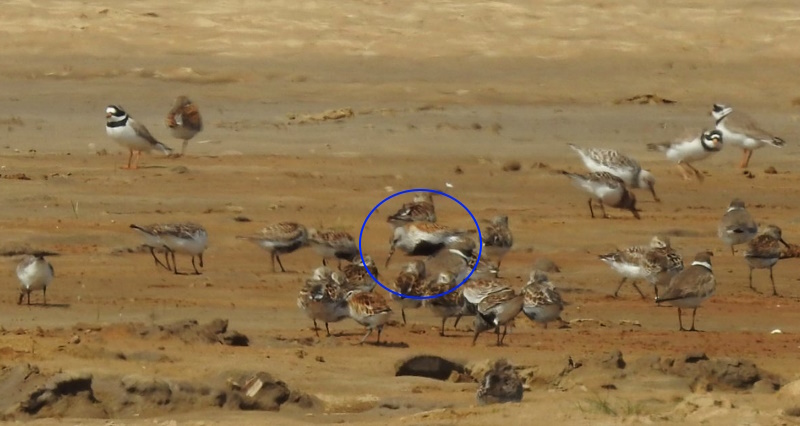
A 'Siberian' Dunlin shown in the blue circle.
Seawatching was fairly quiet but undoubtedly the
highlight was two Puffins off Hilbre on the 7th, and the Black
Guillemot which has been lingering off north Wirral for a few weeks put
in another appearance giving good views from Hilbre on the 13th - see
video on Twitter https://twitter.com/i/status/1657268260151107584.

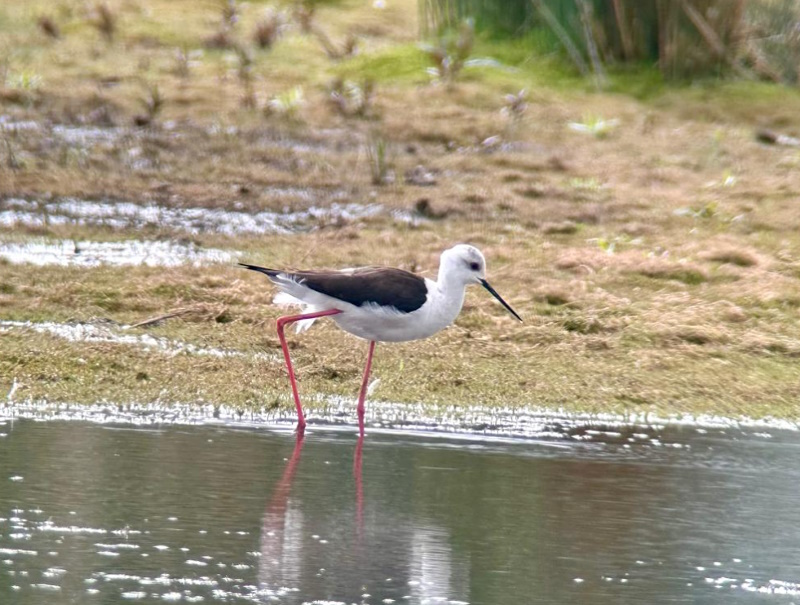
The Black-winged Stilt which was at Burton in April
re-located to
Warren Farm (Talacre) on the 4th before giving good views back at
Burton Mere Wetlands on the 5th. A drake Garganey was recorded several
times at Burton Mere Wetlands during May, is there a female lurking in
the reeds somewhere??
Six Ospreys flew over during May, making a good
total of 22 for the spring. There were several reports of Red Kites
including three over Connah's Quay on the 27th, I wonder if any are
breeding nearby? There are two Marsh Harrier nests at Burton Mere
Wetlands with one male and two females - there have been some
spectacular displays including food passes.

What to expect in June
Some waders will still be heading north in early
June,
look out for small flocks of Sanderlings and Ringed Plovers on the
shore, these may well have flown all the way up from South Africa and
will be heading to the far north to breed. We will also have some
non-breeding waders over-summering here, the odd Whimbrel or two
with a few Oystercatchers and Knots, also we often see a few hundred
non-breeding Black-tailed Godwits at Burton Mere Wetlands and Connah's
Quay. As early as the middle of the month we will start to see the
beginning of
the return migration with the first Spotted Redshanks, Green
Sandpipers, Wood Sandpipers and Little Ringed Plovers. On the estuary
gull numbers will start building, mainly Black-headed Gulls but also
Mediterranean Gulls looking magnificent in full breeding plumage. The
first Sandwich Terns will be returning by the end of the month, these
early arrivals are probably failed or non-breeders, but there will be
a lot more about Sandwich Terns in my next Newsletter.
The Little Terns nesting season will be well
underway in June and a visit to Gronant and Point of Ayr is always a
fantastic experience this time of year, lets hope for good weather and
another good breeding season. At RSPB Burton Mere Wetlands there will
be plenty of Avocet chicks on view on the main scrape and, hopefully,
Lapwings and Redshanks will have had a good breeding season on the wet
grassland. Shelduck broods should also be on view and last year we had
a family of Shovelers to see. Little and Great Egrets will be breeding
on the reserve and it's always possible we will have breeding
Spoonbills and Cattle Egrets, Spoonbills should be present whether
breeding or not.
Look out for hunting Hobbies, and Marsh Harriers
with recently fledged young.
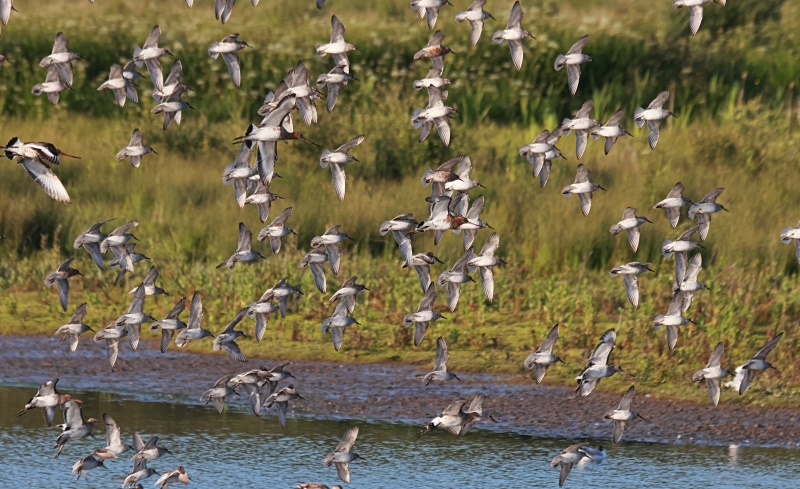
These are non-breeding birds spending the summer here.
Forthcoming Events
June Highest Spring Tides (Liverpool)
Also see Tides page.
4th June, 11.55hrs (BST), 9.1m.
5th June, 12.39hrs (BST), 9.2m.
6th June, 13.27hrs (BST), 9.1m.
Forthcoming Events
Also see events at https://events.rspb.org.uk/deeestuary